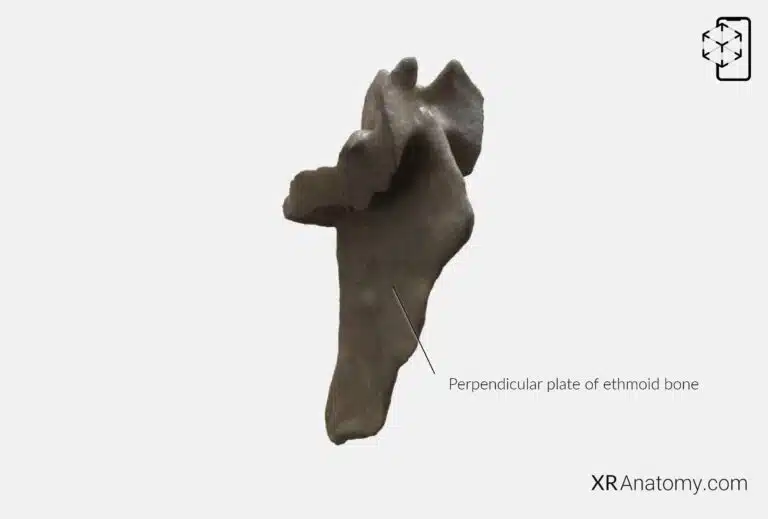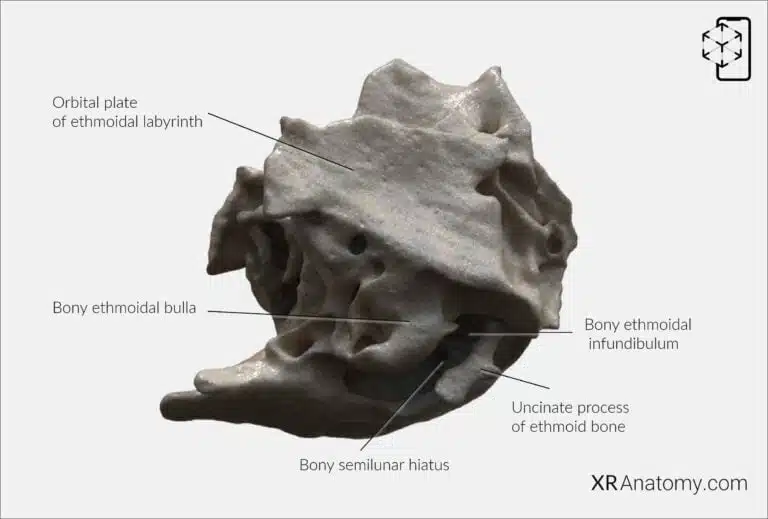ETHMOID BONE
ETHMOID BONE AR ATLAS

AR Figure 40 – Ethmoid bone: Disarticulated View, Augmented Illustration by B. Leahu – MD. This image is licensed under the Creative Commons Attribution-NonCommercial-NoDerivs 3.0 Unported (CC BY-NC-ND 3.0).
The ethmoid bone is an unpaired, cuboid-shaped bone situated between the orbits. It plays a crucial role in forming the anterior cranial fossa, the nasal cavity, and the orbital walls. several bones, including the frontal bone, sphenoid bone, vomer, inferior nasal conchae, palatine bones, lacrimal bones, nasal bones, and maxillae bones, contributing to the complex structure of the skull and nasal passages.

AR Figure 41 – Ethmoid bone, Augmented Illustration by B. Leahu – MD. This image is licensed under the Creative Commons Attribution-NonCommercial-NoDerivs 3.0 Unported (CC BY-NC-ND 3.0).
Structurally, the ethmoid bone comprises four main parts: the , the , and two . These components collectively contribute to the bone's lightweight yet sturdy nature.
CRIBRIFORM PLATE

AR Figure 42 – Ethmoid bone: Cribriform plate, Augmented Illustration by B. Leahu – MD. This image is licensed under the Creative Commons Attribution-NonCommercial-NoDerivs 3.0 Unported (CC BY-NC-ND 3.0).
The is the horizontal component of the ethmoid bone, fitting into the ethmoidal notch of the frontal bone. This deeply grooved structure supports the olfactory bulb and is perforated by numerous small openings called . These foramina allow the passage of the olfactory nerves from the nasal cavity to the brain, facilitating the sense of smell. Rising from the midline of the cribriform plate is the , a vertical bony projection that serves as an attachment point for the falx cerebri, a dural fold that separates the two cerebral hemispheres. Flanking the anterior border of the crista galli are the , which articulate with the frontal bone, further stabilizing the ethmoid bone within the skull.
PERPENDICULAR PLATE OF ETHMOID BONE

AR Figure 43 – Ethmoid bone: Perpendicular plate, Augmented Illustration by B. Leahu – MD. This image is licensed under the Creative Commons Attribution-NonCommercial-NoDerivs 3.0 Unported (CC BY-NC-ND 3.0).
The is a thin, vertical bony lamina that descends from the inferior surface of the cribriform plate. It forms the superior portion of the nasal septum, which divides the nasal cavity into left and right halves. This plate articulates inferiorly with the vomer and anteriorly with the septal cartilage, playing a vital role in supporting the nasal structure and contributing to proper airflow through the nasal passages.
ETHMOIDAL LABYRINTH

AR Figure 44 – Ethmoid bone: Ethmoidal labyrinth, Augmented Illustration by B. Leahu – MD. This image is licensed under the Creative Commons Attribution-NonCommercial-NoDerivs 3.0 Unported (CC BY-NC-ND 3.0).
Flanking the perpendicular plate are the —two lateral masses composed of thin-walled air-filled cavities known as ethmoidal cells or sinuses. These labyrinths are structured and grouped into three main categories: , , and . The anterior cells are located at the front of the labyrinth and are covered by the lacrimal bone. The middle cells lie between the anterior and posterior groups and are covered by the orbital plate of the ethmoid bone, contributing to the formation of the medial wall of the orbit. The posterior cells are situated at the back of the labyrinth and are also covered by the orbital plate.

AR Figure 45 – Ethmoid bone: Lateral view, Augmented Illustration by B. Leahu – MD. This image is licensed under the Creative Commons Attribution-NonCommercial-NoDerivs 3.0 Unported (CC BY-NC-ND 3.0).
The orbital plate of the ethmoidal labyrinth is a thin, smooth bony sheet that covers the middle and posterior ethmoidal cells, forming a significant part of the medial orbital wall. Within the labyrinth, the stands out as a prominent, rounded elevation formed by the middle ethmoidal cells. Anterior to the bulla is the , a curved lamina that descends posteroinferiorly and articulates with the ethmoidal process of the inferior nasal concha. Between the uncinate process and the ethmoidal bulla lies the , a crescent-shaped groove leading into the —a passage that connects to the middle nasal meatus and facilitates drainage of the frontal and maxillary sinuses.
Extending from the medial surface of the ethmoidal labyrinth are the and —thin, curved bony plates that project into the nasal cavity. The is the smallest and highest, forming the upper boundary of the superior nasal meatus. The is larger and hangs down from the labyrinth's inferior border, forming part of the lateral wall of the nasal cavity. These conchae increase the surface area within the nasal passages, enhancing the warming, humidification, and filtration of inhaled air.
BIBLIOGRAPHY
1. Henry G, Warren HL. Osteology. In: Anatomy of the Human Body. 20th ed. Philadelphia: Lea & Febiger; 1918. p. 129–97.
2. Sampson HW, Montgomery JL, Henryson GL. Atlas of the human skull. College Station: Texas A & M University Press; 2007.
4. Saylam C, Özer MA, Ozek C, Gurler T. Anatomical Variations of the Frontal and Supraorbital Transcranial Passages. Journal of Craniofacial Surgery. 2003;14(1):10–2.
5. Hosemann W, Gross R, Goede U, Kuehnel T. Clinical anatomy of the nasal process of the frontal bone (spina nasalis interna). Otolaryngology – Head and Neck Surgery. 2001;125(1):60–5.
6. Steele DG, Bramblett CA. The anatomy and biology of human skeleton. Texas A&M University Press; 1988.
7. Tersigni-Tarrant MTA, Shirley NR. Human osteology. Vol. 4, Forensic Anthropology: An Introduction. 2012. 33–68 p.
8. Monjas-Cánovas I, García-Garrigós E, Arenas-Jiménez JJ, Abarca-Olivas J, Sánchez-Del Campo F, Gras-Albert JR. Radiological Anatomy of the Ethmoidal Arteries: CT Cadaver Study. Acta Otorrinolaringologica (English Edition). 2011;62(5):367–74.
9. Pereira G, Lopes P, Santos A, Krebs. Morphometric aspects of the jugular foramen in dry skulls of adult individuals in Southern Brazil. Vol. 27, J. Morphol. Sci. 2010.
12. Kunc V, Fabik J, Kubickova B, Kachlik D. Vermian fossa or median occipital fossa revisited: Prevalence and clinical anatomy. Annals of Anatomy. 2020 May 1;229:151458.
14. Standring S. The skull. In: Gray’s anatomy: the anatomical basis of clinical practice. 2021st ed. Elsevier Health Sciences; 2021. p. 558–73.
15. Rhoton AL. Chapter 1 Overview of Temporal Bone. Neurosurgery. 2007;
17. Tóth M, Moser G, Patonay L, Oláh I. Development of the anterior chordal canal. Annals of Anatomy. 2006;
18. Carpenter G, Knipe H. Tympanic part of temporal bone. Radiopaedia.org. 2014 Mar 23;
19. Eckerdal O. The petrotympanic fissure: A link connecting the tympanic cavity and the temporomandibular joint. Cranio – Journal of Craniomandibular Practice. 1991;9(1):15–22.
21. Singh R, Kishore Gupta N, Kumar R. Morphometry and Morphology of Foramen Petrosum in Indian Population. Basic Sciences of Medicine. 2020;2020(1):8–9.
23. Piagkou M, Xanthos T, Anagnostopoulou S, Demesticha T, Kotsiomitis E, Piagkos G, et al. Anatomical variation and morphology in the position of the palatine foramina in adult human skulls from Greece. Journal of Cranio-Maxillofacial Surgery. 2012 Oct 1;40(7):e206–10.
